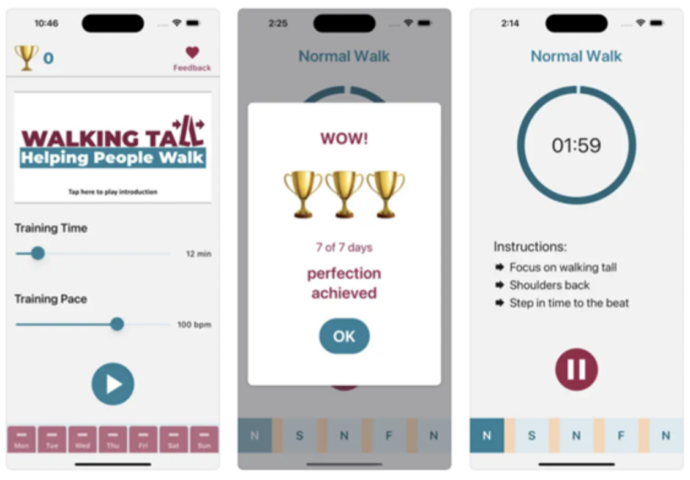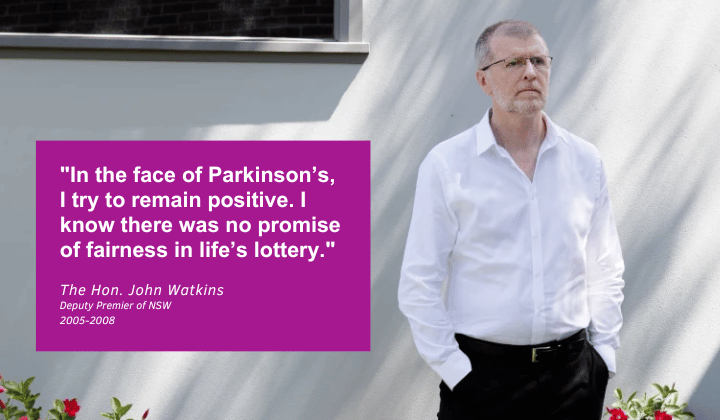New technology application designed to help people with Parkinson’s walk more confidently

Healthy brain region works overtime to control Parkinson’s symptoms
5th November 2024
Eye scans may spot Parkinson’s years before diagnosis
7th November 2024New technology application designed to help people with Parkinson’s walk more confidently

New technology application designed to help people with Parkinson’s walk more confidently
University of NSW biomedical engineers have developed new software that trains people with Parkinson’s to improve their gait.
A new technology application (app), co–designed by people with Parkinson’s disease, has been launched to help those living with the condition learn to walk better and for longer.
A team led by UNSW Sydney biomedical engineer Dr Matthew A Brodie developed the Walking Tall app following a clinical trial funded by Shake It Up Australia Foundation and the Michael J Fox Foundation for Parkinson’s Research.
Part of the trial utilised the app’s gait re–training tool which now allows users to set their own training time and pace before delivering a rhythmic metronomic beat for three different walking speeds that is designed to trigger movement.
The app, which is free to download from the iOS and Android stores, also includes useful instructions such as ‘walk tall’, ‘shoulders back’ and ‘focus on big steps’, as well as providing encouragement via audio commentary.
People living with Parkinson’s can find walking a major challenge given the fact nerve cells deep in their brain responsible for planning and controlling body
movement do not fully function.
Subsequently, they often find their gait becomes impaired, their coordination decreases and step length can be severely affected.
Gait dysfunction
Gait dysfunction can impact negatively on quality of life and independence – and leads to falls in around 70 per cent of people living with Parkinson’s.
“Parkinson’s is a big problem in Australia and it’s exciting to see these new diagnostic tools and interventions coming online,” says Shake It Up Australia Foundation CEO Vicki Miller.
Dr Brodie’s research was conducted at Neuroscience Research Australia’s state–of–the–art facilities in Sydney. Direct comments and suggestions from people with Parkinson’s were then key to the development of the app.
“Those who live with Parkinson’s have to think about every single step they take. We asked them how much mental effort it takes for them to walk, and often they would say 100 per cent,” he says.
“With the metronome beat of the app the aim is to replace the need to think about walking and help with the timing of their steps. This app can give people confidence and also a sense of achievement that they can be empowered and do something for themselves to help their own condition.
“My goal in terms of my research is to have an impact now, not an impact in 10 years’ time. And I believe this app can help people with Parkinson’s all around the world right now.”
Clinical trials
In the clinical trials – which featured 62 people with Parkinson’s – half were able to use a version of the app to help train their gait, while the others followed an existing walking program known as the Otago Exercise Program (OEP).
After 13 weeks, and after analysis of self–reported feedback from those involved in the trial, it was found that those following the traditional OEP training were exercising for around only 60 minutes per week on average, while those using the app trained for 150 minutes.
In the meantime, researchers have separately developed the app further and hope to provide people with Parkinson’s immediate benefits based on the positive feedback of those who used it during the trial.
It now features specific training sessions split into five different walks, plus rest periods, with users guided to try to walk at slow and fast speeds, as well as a normal pace.
“We’re training them in gait adaptability. Sometimes they also need to visualise a walking style because often people with Parkinson’s experience hypokinesia where their movements are not actually as big as they feel they are,” says Dr Brodie, who
has subsequently created a spin–off company called Walking Tall Health.
“So we are encouraging them to take exaggerated steps, which will actually be more like regular steps. The feedback we got from the trials is that the people who used the app really liked the simple metronome beat via their phone that helped to
stabilise their gait.
“What we have found is that once people become engaged, and they find they are getting the benefits, then they actually want to do more. All they have to do is tap one button on their smartphone and they can start exercising, even just up and down the corridor in their home.
“We also give them audio encouragement in the app and you can even ‘earn’ a gold cup if you complete the training over a number of days. All of that is another motivator for people.”
Walking Tall Health’s chief science officer, Dr Martin Ostrowski, himself lives with Parkinson’s. He is also a Board Member of Parkinson’s NSW.
Source:
University of NSW Newsroom



